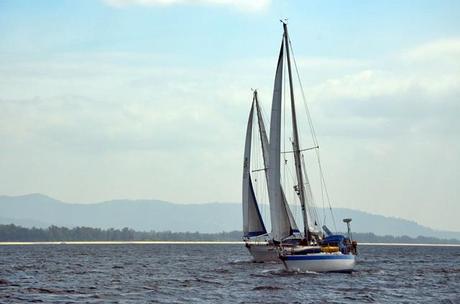
We like to think we're pretty observant about the world around us. In this region vigilance is essential, thanks to the many fish traps and unattended fish nets in local waters. A thin stake with a ragged flag, a piece of Styrofoam that is the body double of floating garbage may be the only sign of prop-snagging lines in our path. There were masses of these as we worked our way coastwise to the north from Phuket, so Jamie and I spent a lot of time glued to the scenery around us. With glorious sailing weather (finally, after so many miles of motoring or motorsailing) it was hardly a burden.

A few boats headed north at the same time, as eager as we were for a break from the crowds in Phuket. Traveling in company means the chance for a few shots of boats under sail.

You know the saying- if there's another boat on the horizon, you're racing? Jamie was in his element as we


The province north of Phuket is the least populated in Thailand. Only a handful of communities broke the wall of green and occasional beaches along the way. That, and approximately 100,000 fish traps.

At one point, we passed a shipyard, with what appeared to be bamboo frames forming a grid for scaffolding to work on boats careened on the sand.

To the north end was a rusted out cruise ship- I snapped a few shots as we went by.

After arriving in Koh Phayam, we settled in with the sunset. Niall was flipping through pictures from the trip north and got to the few of that rusted old hulk. He called to me, frustration in his voice. "Why didn't you tell me that we passed a World War II era wreck?" Well...because I didn't know we had? So much for the powers of observation.
Niall's interest in WWII started a few years ago, but kicked into high gear while we were in Papua New Guinea in 2012 and had the chance to see and explore a number of wrecks, on land and in the water. It was immediately obvious to him that what Jamie and I took for an an abandoned commercial ship was an LST (landing ships that carried tanks and personnel, landing them on an unimproved shoreline). We even discussed it as we sat in the cockpit, passing by, wondering about the fate of the rusty hulk.
He's a researcher like his mama, so Niall dug in to try and identify the original name of the ship. We didn't see anything obvious at first blush, just what appeared to be a Thai name. He found that a number of LSTs had been sold to the Thai navy after the war, and their names carried a theme: Lincoln County, Stark County, Stone County, Dodge County. Zooming in, there appears to be a match with one of the "missing" LSTs, Dodge County.

Two of the sites that Niall uses to find and reference information about the wrecks we've seen, PacificWrecks and NavSource, don't have a current location for the Dodge County. He dug further, and couldn't find it anywhere- it was just noted as lost. He's thrilled to have "found" this lost ship and set about providing updated data to the websites... and composing a poem to LST-722, Dodge County.
Commissioned at the close of forty-fourI love it when our children teach us a lesson. That this came with a reminder to look deeper: smug as we were, feeling so observant from our floating perch.
She departed to serve on many a shore
And this she did with great renown
Till the end of the war had come around
She cheated the sea of a grave so deep
Instead lies beached in eternal sleep
With the retention and memories of her captain and crew
Of the old LST, seven twenty-two
----
If you're reading this on the Sailfeed website, you're a reader with a keen sense of observation. Thank you! Thanksn also to the crew of Kittani for sharing their photos of Totem.

